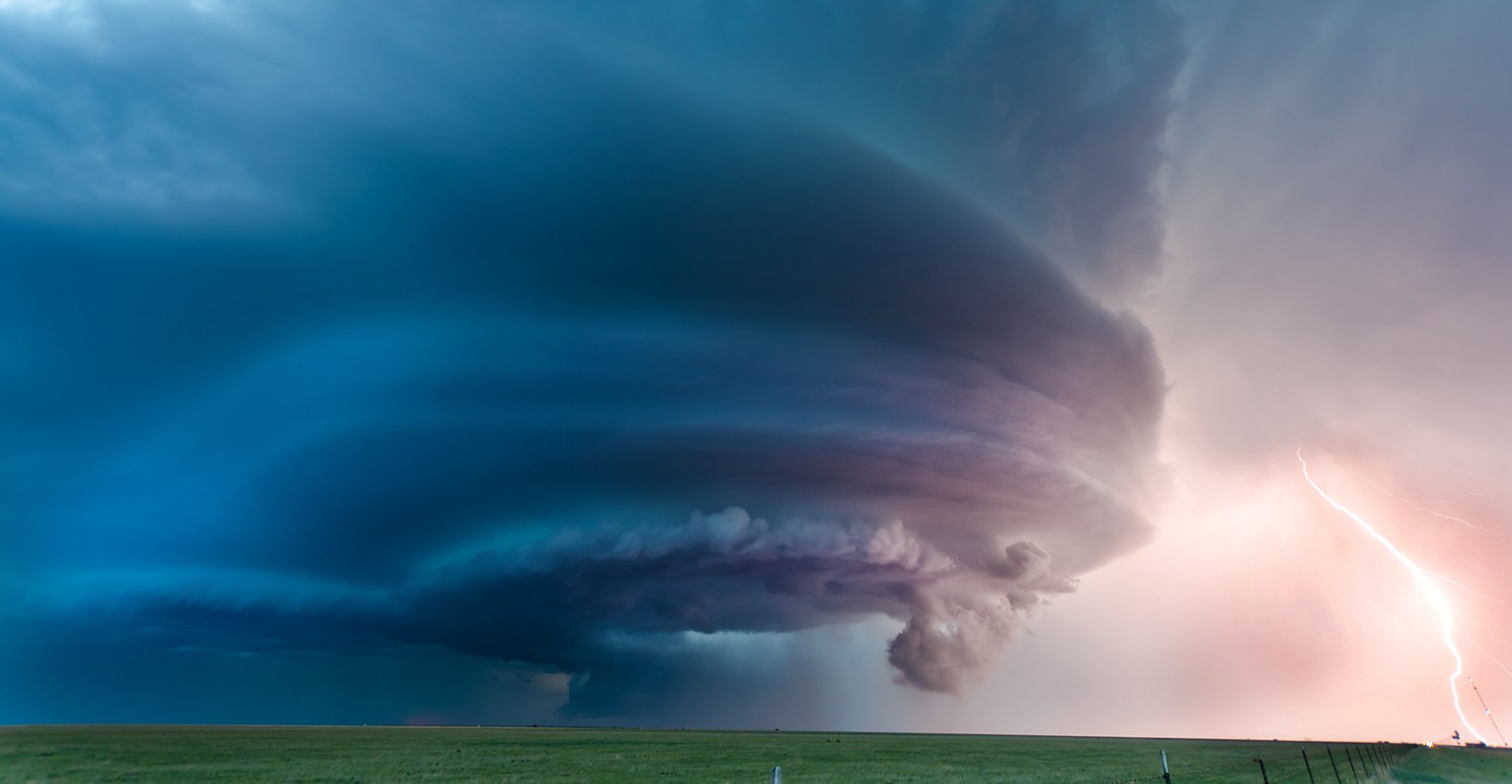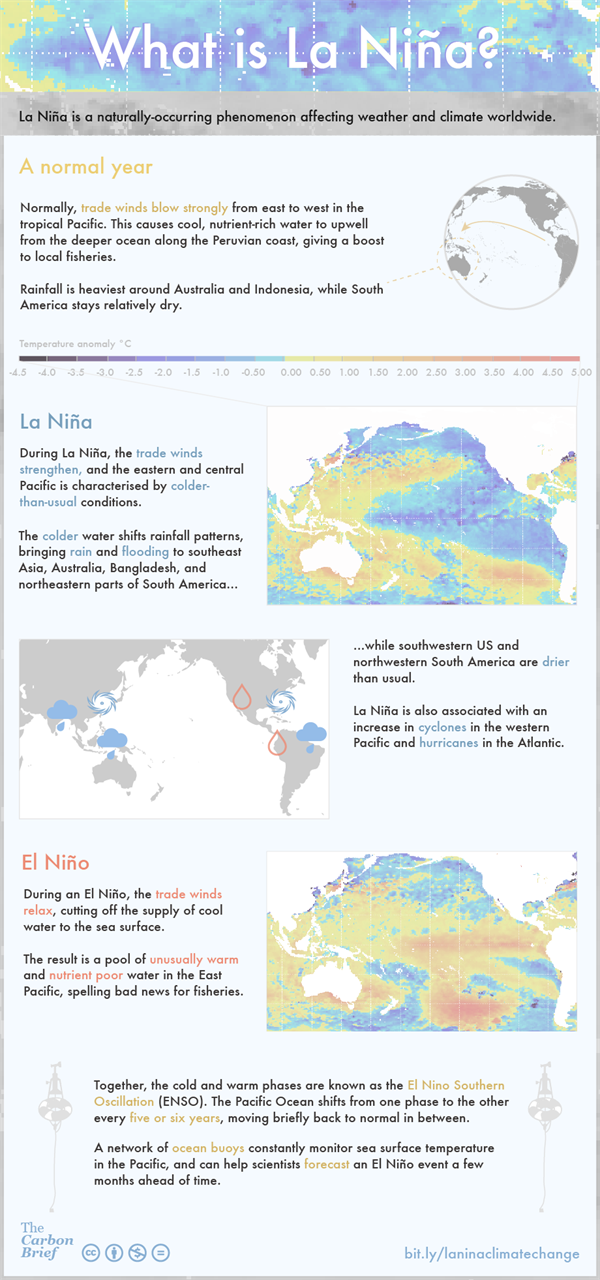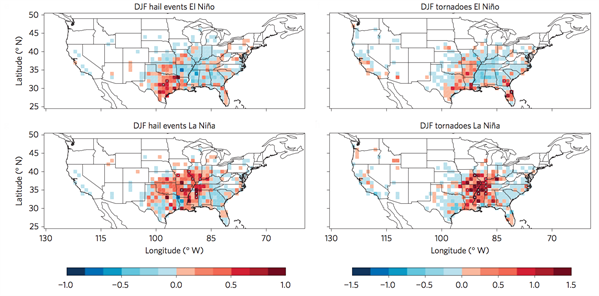
La Niña boosts the odds of tornadoes and hailstorms in the US, study shows
Robert McSweeney
03.16.15Robert McSweeney
16.03.2015 | 4:00pmLast week, scientists announced the arrival of a long-awaited El Niño event. It’s well known that El Niño triggers extreme weather around the world. But a new study published today shows how the event’s little sister, La Niña, can be destructive too.
La Niñas tend to bring more tornadoes and hailstorms to the southern US, the study finds. Knowing this will allow scientists to forecast hail and tornado frequency a season in advance for the first time, the lead author tells Carbon Brief.
El Niño and La Niña
Every five years or so, weakening trade winds cause a shift to warmer than normal ocean temperatures in the eastern equatorial Pacific Ocean. The phenomenon, known as El Niño, has a cold water counterpart, called La Niña. During La Niña, the opposite happens. The trade winds strengthen and the central and eastern Pacific Ocean become colder than normal.
Together, these warm and cold events form the El Niño-Southern Oscillation (ENSO), and cause most of the fluctuations in global weather we see from one year to the next.
The impact of ENSO events can be dramatic. La Niñas, for example, are known to bring floods to Central and South America, and hurricanes to the Atlantic Ocean.
Now a new paper, published in Nature Geoscience, suggests there could be a link with a different type of extreme weather event. The southern US is on the receiving end of more tornadoes and hailstorms during La Niña events and fewer during El Niños, the research finds.
Credit: Rosamund Pearce, Carbon Brief
Damage and deaths
Tornadoes, hailstorms and severe winds cause an average of $1.6 billion of damage per year across the US. Last year, 47 people were killed by tornadoes, but during the last La Niña event in 2011, the number was over 550, the paper notes.
These types of severe storms can be difficult to measure. Tornadoes, for example, can flare up and dissipate rapidly, making them hard to sample and easy to miss entirely. This lack of good data makes studying changes in tornadoes and hailstorms over time difficult.
To get around this problem, the new research goes back a step. The study looks at the wind, heat and moisture conditions that the storms need to kick into gear, for which scientists have better records.
The researchers built a model to pinpoint when conditions combined to favour tornadoes and hailstorms events between 1979 to 2003. Then, they checked their results against how many tornadoes and hailstorms were actually recorded over the same time period.
Satisfied the model did a good job of predicting when tornado and hail events had occurred, the researchers worked out how many of them took place in El Niño or La Niña years.
More severe storms during La Niña
The maps below show the results. The first set show the number of hailstorms and tornadoes in winter, while the second set show spring numbers. Red squares represent increases, and blues represent decreases. The darker the colour, the larger the impact.
Maps showing changes to frequency of hailstorms (left-hand graphs) and tornadoes (right-hand graphs) during El Niño events (top graphs) and La Niña events (bottom graphs) in winter. Increases (red squares) and decreases (blue) are in average number of events per season in each 100km grid square. Source: Allen et al. (2015)
Tornadoes and hailstorms were more likely to occur during La Niña events for many of the southern states of the US, as shown by the darker reds in the La Niña maps above.
Conversely, the blue areas across much of the El Niño maps show tornadoes and hailstorms were less likely during these type of events.
La Niña events had the largest effect on severe weather during spring, with some places experiencing three or four more hailstorms and tornadoes per season, the paper notes.
Maps showing changes to frequency of hailstorms (left-hand graphs) and tornadoes (right-hand graphs) during El Niño events (top graphs) and La Niña events (bottom graphs) in spring. Increases (red squares) and decreases (blue) are in average number of events per season in each 100km grid square. Source: Allen et al. (2015)
Shifting jet stream
So how do ENSO events affect severe storms? Lead author Dr John Allen, a research scientist at Columbia University, tells Carbon Brief it’s down to the position of the jet stream over the US.
During a La Niña event, this fast-flowing river of air high up in the atmosphere, shifts northwards. This drags warm, moist air up from the Gulf of Mexico, which increases the chance of big, rotating storms, Allen explains:
“This puts the southeast more in the firing line, with 20-150% more than normal tornado and hail frequency.”
But as hail and tornadoes depend heavily on local weather conditions, there’s no guarantee that La Niña will result in more extreme weather, Allen adds:
“This doesn’t mean you will definitely see tornadoes or hail, just that the environment is more favourable to their occurrence.”
When an El Niño emerges in the Pacific, the opposite happens, Allen says. The jet stream moves southwards and cool, drier air is pulled down from the Great Plains, meaning the region tends to experience fewer severe storms.
A quiet spring
Making this connection between ENSO and severe weather means scientists can estimate how many tornadoes and hailstorms the southern states of the US will get in spring, Allen explains, based on the whether the previous winter sees a warm or cold ENSO event.
These won’t tell you what will happen on a day-to-day basis, Allen adds, but should provide an outlook for whether hail and tornado frequency will be above or below average.
With the arrival of El Niño last week, the US should expect a relatively quiet spring for severe storms, Allen says. But that’s not to say the weather will be entirely peaceful, he cautions:
“It’s important to remember that even the most quiet seasons still produce 800 tornadoes.”
These advances are very useful, Prof Kevin Trenberth from the US National Center for Atmospheric Research tells Carbon Brief. But the next step should be to look at ENSO events of different strengths, he says:
“[The study] should be a starting point for more detailed work that accounts for the different flavours of El Niño and La Niña in order to become more reliable for predictions.”
With the destruction tornadoes can leave in their wake, any advance in forecasting capability is good news. And with recent research suggesting climate change could mean we experience extreme La Niña events twice as often in the future, forecasting could prove even more critical.
Main image: Supercell near Vega, Texas – May 2012.
Allen, J.T. et al. (2015) Influence of the El Niño/Southern Oscillation on tornado and hail frequency in the United States, Nature Geoscience, doi:10.1038/ngeo2385
-
La Niña boosts the odds of tornadoes and hailstorms in the US, study shows




